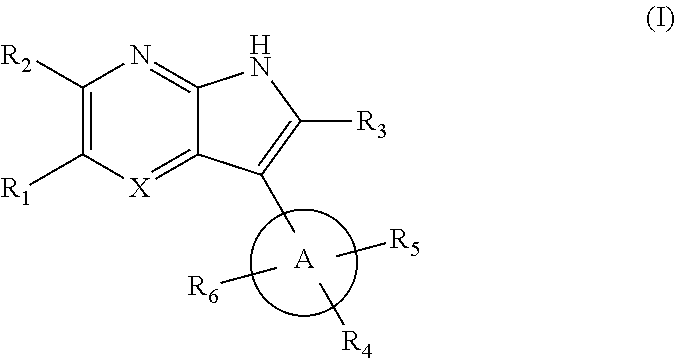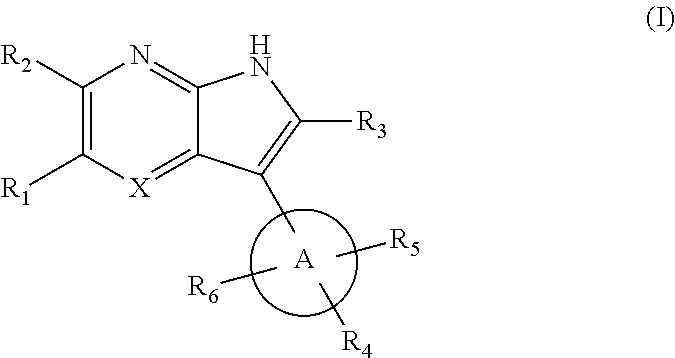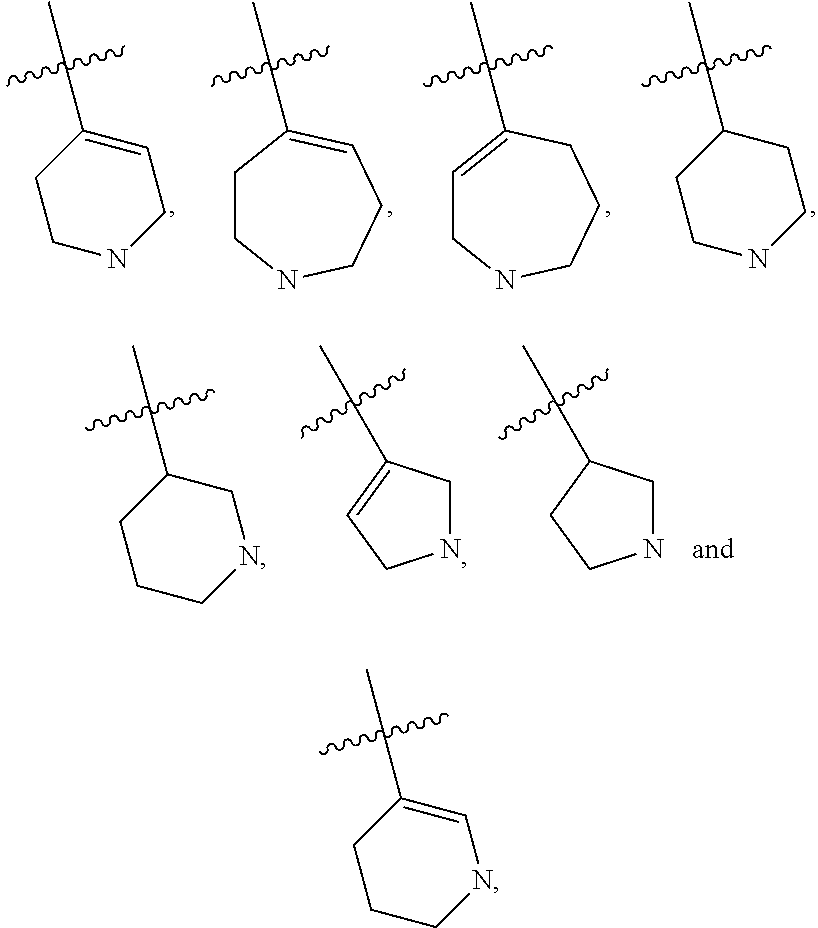7-azaindole or 4,7-diazaindole derivatives as ikk epsilon and tbk1 inhibitor and pharmaceutical composition comprising same
a technology of 7-azaindole and derivatives, applied in the field of 7-azaindole or 4, 7-azaindole derivatives as ikk, can solve the problems of inhibitors that have not yet been commercialized, inhibition and recurrence of malignant tumors still remain unresolved,
- Summary
- Abstract
- Description
- Claims
- Application Information
AI Technical Summary
Benefits of technology
Problems solved by technology
Method used
Image
Examples
preparation example 1
Preparation of 3-(1,2,3,6-tetrahydropyridin-4-yl)-1H-pyrrolo[2,3-b]pyridine (compound 5)
[0350]
[0351]wherein,
[0352]each of R1 to R5 is H, methyl or ethyl, and R6 is aryl or heteroaryl.
[0353]As shown in the reaction scheme, aryl or heteroaryl is introduced to the 5th position of azaindole via a Suzuki-coupling reaction, and introducing tetrahydropyridine to the 3rd position of azaindole to give the compound of formula (V).
example 1
4-((5-(3-(1-Methyl-1,2,3,6-tetrahydropyridin-4-yl)-1H-pyrrolo[2,3-b]pyridin-5-yl)thiophen-2-yl)methyl)morpholine
Step 1: Preparation of 4-((5-(1H-pyrrolo[2,3-b]pyridin-5-yl)thiophen-2-yl)methyl)morpholine (7)
[0354]
[0355]To a solution of DME: H2O=4:1(v:v) (20 mL) was added 5-bromo-1H-pyrrolo[2,3-b]pyridine (1.5 g, 7.61 mmol), cesium carbonate (7.44 g, 22.84 mmol), 4-((5-(4,4,5,5-tetramethyl-1,3,2-dioxaborolan-2-yl)thiophen-2-yl)methyl)morpholine (2.82 g, 9.14 mmol) and palladium tetrakis (0.440 g, 0.381 mmol). The reaction mixture was stirred at 130° C. for 12 hours. The resulting mixture was diluted with H2O and extracted with EtOAc. The organic layer was dried over anhydrous Na2SO4, filtered and concentrated in vacuo. The residue in SiO2 phase was purified by silica chromatography to give the title compound (1.5 g, 5.01 mmol, 65% yield).
Step 2: Preparation of 4-((5-(1H-pyrrolo[2,3-b]pyridin-5-yl)thiophen-2-yl)methyl)morpholine (7)
[0356]
[0357]4-((5-(1H-pyrrolo[2,3-b]pyridin-5-yl)thio...
example 2
5-(3,4-Dimethoxyphenyl)-3-(1-methyl-1,2,3,6-tetrahydropyridin-4-yl)-1H-pyrrolo[2,3-b]pyridine
[0359]
[0360]1H NMR (400 MHz, CDCl3) δ 9.66 (br s, 1H), 8.52 (s, 1H), 8.30 (s, 1H), 7.66 (s, 1H), 7.19-7.17 (m, 1H), 7.14 (s, 1H), 7.03-7.01 (d, J=8.3 Hz, 1H), 6.21 (br s, 1H), 4.01 (s, 3H), 3.97 (s, 3H), 3.26 (br s, 2H), 2.82-2.79 (m, 2H), 2.70 (br s,), 2.51 (s, 3H); [M+H]+ 350.
PUM
| Property | Measurement | Unit |
|---|---|---|
| Force | aaaaa | aaaaa |
| Volume | aaaaa | aaaaa |
| Mass | aaaaa | aaaaa |
Abstract
Description
Claims
Application Information
 Login to View More
Login to View More - R&D
- Intellectual Property
- Life Sciences
- Materials
- Tech Scout
- Unparalleled Data Quality
- Higher Quality Content
- 60% Fewer Hallucinations
Browse by: Latest US Patents, China's latest patents, Technical Efficacy Thesaurus, Application Domain, Technology Topic, Popular Technical Reports.
© 2025 PatSnap. All rights reserved.Legal|Privacy policy|Modern Slavery Act Transparency Statement|Sitemap|About US| Contact US: help@patsnap.com



